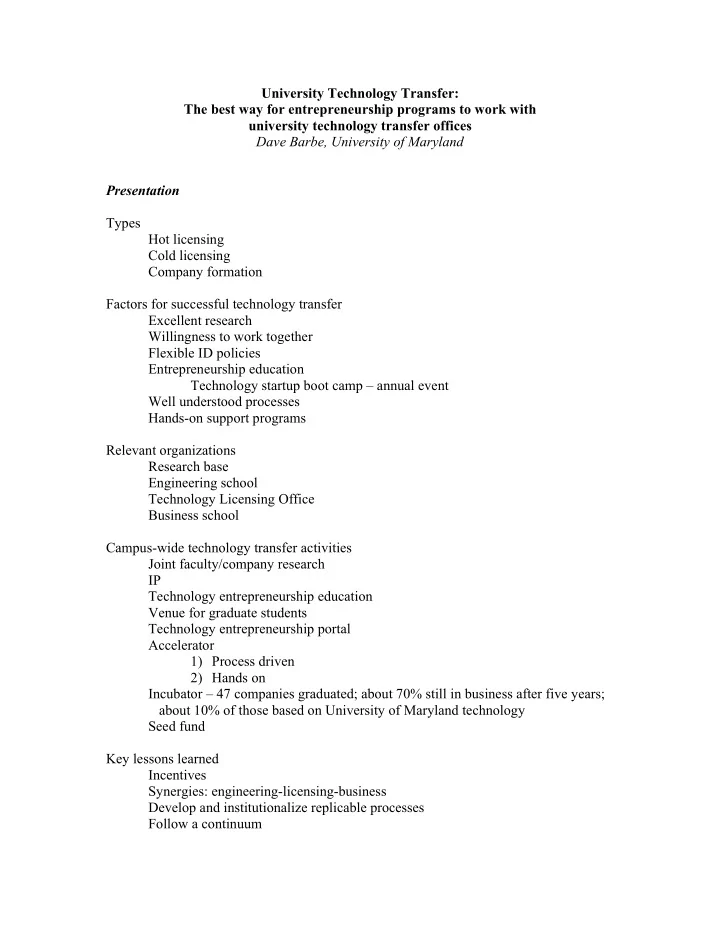

University Technology Transfer: The best way for entrepreneurship programs to work with university technology transfer offices Dave Barbe, University of Maryland Presentation Types Hot licensing Cold licensing Company formation Factors for successful technology transfer Excellent research Willingness to work together Flexible ID policies Entrepreneurship education Technology startup boot camp – annual event Well understood processes Hands-on support programs Relevant organizations Research base Engineering school Technology Licensing Office Business school Campus-wide technology transfer activities Joint faculty/company research IP Technology entrepreneurship education Venue for graduate students Technology entrepreneurship portal Accelerator 1) Process driven 2) Hands on Incubator – 47 companies graduated; about 70% still in business after five years; about 10% of those based on University of Maryland technology Seed fund Key lessons learned Incentives Synergies: engineering-licensing-business Develop and institutionalize replicable processes Follow a continuum
Seek community support Questions What are the best ways for entrepreneurship programs to work with TLOS? : : Discussion Incentives for faculty to work with companies. How move away from NSF etc. to company-supported research? Engineers desire to have their research come to fruition in a product. University of Maryland fund for joint/collaborative research Role of state resources. In University of Maryland case, push from School of Engineering board for greater involvement with industry. Proposal to State. Incubator limited to companies that will be based in Maryland after acceptance. Large company maximum funds of $100k/year for up to two years Startup: $7k/year? Stanford experience Encourage graduate students to take classes in entrepreneurship. Keep OTL involved early in process. How is student-generated research handled? At University of Maryland, the university owns graduate student research. Undergraduates generally hold their own unless research is preformed jointly with faculty. Pennsylvania State(?) – use of student teams to support TTO Helsinki The problem is that so few technologies make it. Technology transfer shouldn’t waste time finding few winners. Use students to sift possibilities. Agreement with Nokia to use student groups to evaluate new product possibilities. USC Formal disclosures versus informal discoveries. “Scavanger hunt” for technologies. Use of students for this. Challenge: these kinds of activities don’t take place on an academic timeline. Solution: set up internship program to facilitate “SWAT team” of MBA students who can do so Duke
New Ventures Clinic – puts together team of MBA students, also law and engineering. Find ideas among faculty research. Southeast tech inventions – similar scavenger hunt USC Techs posted for licensing versus those that have commercial potential Also, need to post dockets in plain English. Engineering Tech Transfer Center Problem: so many technologies disclosed. Difficult to evaluate. UCLA Venture Development Project – based at Anderson. Matches business and lab teams. Program itself attempts to provide continuity even as team composition changes due to academic calendar. Course sequence that follows product development How do you determine what to patent, actively shop, etc. Stanford: licensing associate decides, with input from inventor, colleagues, etc. Partnership between Stanford Biodesign and OTL. Biodesign has a technology assessment group that meets monthly – includes VC, OTL, successful entrepreneurs in this space Use of catalyst – seed funding, MBA students, outside mentor(s) Importance of particular faculty matches – i.e., difficult researchers. Importance of deep involvement of faculty Process versus people State law and public universities
Recommend
More recommend